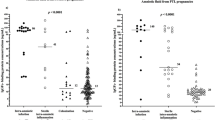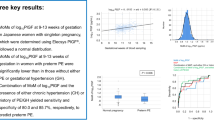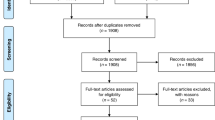Abstract
OBJECTIVE: To evaluate serum procalcitonin concentration in umbilical cord blood for diagnosis of intrauterine bacterial infection.
MATERIALS AND METHODS: A prospective study was conducted between 2000 and 2001. Serum procalcitonin concentrations were evaluated in 187 umbilical cord blood samples. Five groups have been defined: controls A (n=37), full-term noninfected B1 (n=80) and infected neonates B2 (n=8), preterm noninfected C1 (n=38) and infected C2 (n=24) newborns. An immunoluminometric assay was used to determine procalcitonin concentration. The Mann–Whitney U-test and Spearman's correlation ratio were applied. The sensitivity and specificity, the positive and negative predictive values, and the area under receiver operating characteristic curves were calculated.
RESULTS: A statistically higher serum procalcitonin concentration was found in the preterm infected group (p<0.005; C2 vs A and C1).
CONCLUSION: Serum procalcitonin concentration in umbilical cord blood may be a useful parameter in the diagnosis of early neonatal infection.
This is a preview of subscription content, access via your institution
Access options
Subscribe to this journal
Receive 12 print issues and online access
$259.00 per year
only $21.58 per issue
Buy this article
- Purchase on Springer Link
- Instant access to full article PDF
Prices may be subject to local taxes which are calculated during checkout


Similar content being viewed by others
References
Stoll BJ, Gordon T, Korones SB, et al. Early-onset sepsis in very low birth weight neonates: A report from the National Institute of Child Health and Human Development Neonatal Research Network. J Pediatr 1996;129:72–80.
Remington JS, Klein JO, editors. Current concepts of infections of the fetus and newborn infant. In: Infectious Diseases of the Fetus and Newborn Infant. Philadelphia: Saunders; 1995. p. 1–19.
Assicot M, Gendrel D, Carsin H, et al. High serum procalcitonin concentrations in patients with sepsis and infection. Lancet 1993;341:515–518.
Dandona P, Nix D, Wilson MF, et al. Procalcitonin increase after endotoxin injection in normal subjects. J Clin Endocrinol Metab 1994;79:1605–1608.
Brunkhorst FM, Heinz U, Forycki ZF . Kinetics of procalcitonin in iatrogenic sepsis. Int Care Med 1998;24:888–889.
Chiesa C, Panero A, Rossi N, et al. Reliability of procalcitonin concentrations for the diagnosis of sepsis in critically ill neonates. Clin Infect Dis 1998;26:664–672.
Monneret G, Labaune JM, Isaac C, et al. Increased serum procalcitonin levels are not specific to sepsis in neonates. Clin Infect Dis 1998;27:1559–1560.
Lapillone A, Basson E, Monneret G, et al. Lack of specificity of procalcitonin for sepsis diagnosis in premature infants. Lancet 1998;351:1211–1212.
Assuma M, Signore F, Pacifico L, et al. Serum procalcitonin concentrations in term delivering mothers and their healthy offspring: A longitudinal study. Clin Chem 2000;46(10):1583–1587.
Sachse C, Dressler F, Henkel E . Usefulness of procalcitonin in neonates at risk for infection [Letter]. Clin Chem 1999;45:441.
Sachse C, Dressler F, Henkel E . Increased serum procalcitonin in newborn infants without infection. Clin Chem 1998;44:1343–1344.
Gendrel D, Assicot M, Raymond J, et al. Procalcitonin as a marker for the early diagnosis of neonatal infection. J Pediatr 1996;128:570–573.
Janota J, Stranak Z, Belohlavkova S . Interleukin-6, procalcitonin, C-reactive protein and the immature to total neutrophil ratio (I/T) in the diagnosis of early-onset sepsis in low birth weight neonates. Ceska Gyn 2000;65:29–33.
Franz AR, Krom M, Pohlandt F, et al. Comparison of procalcitonin with interleukin-8, C-reactive protein and differential white blood cell count for the early diagnosis of bacterial infections in newborn infants. Pediatr Infect Dis J 1999;18:666–671.
Tollner U . Early diagnosis of septicaemia in the newborn: Clinical studies and sepsis score. Eur J Pediatr 1982;138:331–337.
Mathers NJ, Pohlandt F . Diagnostic audit of C-reactive protein in neonatal infection. Eur J Pediatr 1987;146:147–151.
Hatherill M, Tibby SM, Sykes K, et al. Diagnostic markers of infection: comparison of procalcitonin with C reactive protein and leucocyte count. Arch Dis Child 1999;81:417–421.
Acknowledgements
This work was supported by Grant KBN 4 P05E 138 19.
Author information
Authors and Affiliations
Additional information
Serum procalcitonin concentration in umbilical cord blood may be a useful parameter in the diagnosis of intrauterine bacterial infection in newborn infants.
Rights and permissions
About this article
Cite this article
Kordek, A., Giedrys-Kalemba, S., Pawlus, B. et al. Umbilical Cord Blood Serum Procalcitonin Concentration in the Diagnosis of Early Neonatal Infection. J Perinatol 23, 148–153 (2003). https://doi.org/10.1038/sj.jp.7210885
Published:
Issue Date:
DOI: https://doi.org/10.1038/sj.jp.7210885
This article is cited by
-
Cerebrospinal fluid procalcitonin as a biomarker of bacterial meningitis in neonates
Journal of Perinatology (2017)
-
Inflammatory markers in cord blood or maternal serum for early detection of neonatal sepsis—a systemic review and meta-analysis
Journal of Perinatology (2014)
-
Neonatal Procalcitonin Intervention Study (NeoPInS): Effect of Procalcitonin-guided decision making on Duration of antibiotic Therapy in suspected neonatal early-onset Sepsis: A multi-centre randomized superiority and non-inferiority Intervention Study
BMC Pediatrics (2010)



